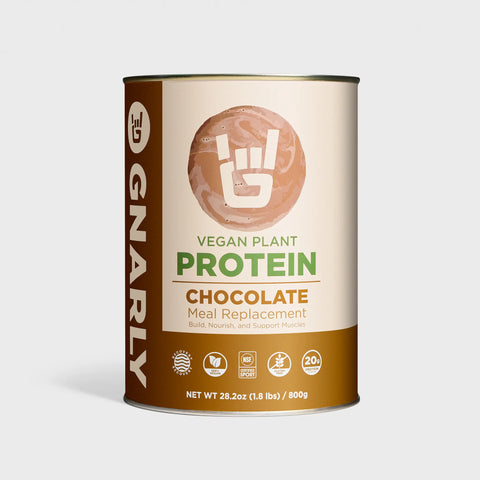We all make countless decisions everyday. Some of them work to our advantage, like drinking a collagen spiced chai latte in the morning before a workout. Other decisions don’t go so well and can derail our plans. Sometimes the difference between an advantageous decision and a massive mistake doesn’t become evident until it’s way too late. To help avoid the latter, we checked in with some Gnarly runners to go over what they’ve learned about nutrition. Years of performing as professional athletes have taught all of them heaps about what works best for their bodies. While yours isn’t identical to theirs, sometimes hearing about one person’s lessons can make a huge difference in our nutrition decisions.
Kelly Halpin - Fastest Known Time warrior
When I first started doing endurance sports and long distance running, I wasn’t very good at consuming the proper amount of calories and hydration per hour. I sort of winged everything and then didn’t fully understand why I was crashing or becoming nauseated. I now understand that if I want to sustain my energy over time, I need to fuel every 30 to 45 minutes and stay on top of drinking water, plus the proper amount of sodium.
Raleigh Distance Project runner Lauren Archer
As soon as I finish a long run, hard workout, or race, the clock is ticking. I know that I have at most 60 minutes to get some protein down [for optimal recovery gains!] In high school and even college, I didn’t prioritize this or realize how significant that time window is. I would drive, shower, change and get distracted before consuming any carbs or protein. While I used to think that waiting for a next meal wasn’t a big deal, I realize now that doing so is a missed opportunity to maximize recovery and rebuild muscle so that I can gain the fitness benefits of all the work I just put in and am primed for my next run. I like to leave Gnarly Nutrition Vegan Protein in my car so that I can just fill a bottle with water before driving to my workout or run location and scoop in some protein immediately post-run.
Post-race, I try to get something down before or directly after my cooldown like a banana and a handful of nuts or nut butter, a protein bar, beef jerky or a protein shake. And something is better than nothing – yes, I’ve had a slice of pizza at the finish line!
Ultrarunner badass Tara Warren
I wish I had known that taking liquid nutrition can actually taste good. That seems so simple but there are so many products on the market right now that taste awful. I hear about people taking them because that's what they think they have to take, but there are actually good products on the market right now that taste good! As an ultra runner, that's so important. You don't have to take things that taste like powdered nutrition, you can take legitimately good fuel that works for you. Specifically, Gnarly Fuel₂O - you can consume it and it's not going to upset your stomach since it's formulated so that when you drink it, you don’t have a high and then a low again or start on that cycle.
I'm a coach and I'll tell my clients that fuel can actually taste good, and don't be fooled by it tasting good, it's doing good stuff for you too. You can take any of these Gnarly products and feel satisfied that you're putting real products into your body; the products do the things that they say they’re going to do without tasting like garbage.
Raleigh Distance Project runner Caity Ashley
When I was younger and starting to think more critically about fueling my body for sport and performance, I focused on choosing foods that were going to do a lot of good things for my body. Choosing whole grain and complex carbohydrates was a part of that. A lot of times this meant choosing a whole grain starch instead of something that was simpler or more refined. Now as an athlete, I rely heavily on a good mix of both. Simple carbohydrates are such an important energy source for athletes to provide our muscles and brains with fuel that can be utilized quickly without a whole lot of breakdown required.
Ultrarunner and endurance coach Ben Light
I think everybody sees progression in their nutrition and continues to refine it over and over. I had a pivotal nutritional moment in 2019 when I went to Spain and France to run the Pyrenees mountains. My main food source was going to be a drink mix and dehydrated meals, so everything was dependent on adding water. There was supposed to be plenty of water in the Pyrenees so I could have lightweight fuel and then just filter water to add to my nutrition as I went across. But all of the springs had dried up and I slowly got more and more behind on hydration and ended up having to pull out because I got heat stroke.
After that, I changed up my entire nutrition plan. That's when I made the transition to using fat as more of a fuel base. I still do glucose and carbs, but I just don't need as much on long runs now because I'm utilizing fat storages within myself more.
When I’m shifting around with nutrition, playing with or tweaking different things, I make small changes and assess rather than large changes. If you do large changes or too many variations, you don't know exactly what part of that variation actually made the difference. I just started to move taking Gnarly Performance Greens from the morning to the evening because I wanted to run a little bit more fasted in the morning.
Overall, I don't know if I would have done anything different over the years with nutrition. I progressed and I evolved over these years, and I could look back and say, “Oh, I wish I would have known what I know now,” but that's not how life works, and that's not how growth works.
Climber and strength coach Joslynn Peterson
When I ran in college I really had no idea about nutrition. We were given the basics of nutrition but honestly, I still didn't understand. I think they didn't simplify it enough or explain it in an actionable way. They explained the amounts, but they didn’t cover what that should look like when the athlete goes to the store, so we didn’t know what to buy or how to fuel.
I didn't have any supplements and I was always anemic in college. My coach would get so mad at me and I did not understand because I felt like I was getting in trouble for something that I didn't have control over, and I didn't understand how to fix it.
The biggest thing that changed for me was when I started studying nutrition by taking courses in college. To be honest, it still felt really complicated, especially with the timing of what we need. I felt that I learned things and then came out of it only questioning more aspects of nutrition. But that’s what I would say is so awesome about Gnarly products; they simplify everything.
The reality is that when you're in that training mode, it can be exhausting to pay attention to everything. You're tired and you’re spending so much time training, so using Gnarly products means making sure that everything is available at any time. It's really the best.
If I’m going on a trail run or to more remote places it is harder to bring all those vegetables or make sure you're eating everything before it spoils, so I always pack Gnarly Performance Greens. Then I don’t have to worry about getting the right nutrients.
I trained for an ultra in college and for the life of me I could not figure out how to eat while running. I tried to eat gummy worms but you don't realize that you can't breathe when you're trying to eat gummy worms. Now it's so easy for me to know that I'm getting calories with Gnarly Fuel₂O.
That’s the black and white difference for me and nutrition, is that it's so easy now and I never feel like I'm going to bonk. In fact, what gives out first is my ankles, not my energy.
Raleigh Distance Project runner Emma Spencer
When I first started running marathons, I didn’t hydrate on long runs since I didn’t feel thirsty. As I learned more about performance fueling, I realized I was negatively affecting my post-run recovery by not staying on top of hydration. Now I make sure to drink water and electrolytes before and during my run. It’s a little more work to stash water bottles along my running route but worth it for my training!




